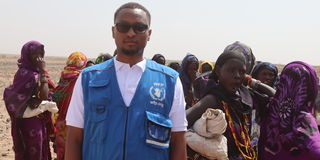Food agency warns over worsening hunger in northern Kenya

WFP Marsabit Field Office monitoring and evaluation Officer Samuel Kiarie during an interview at El Beso village, North Horr on June 25,2022. He painted a grim picture of food security due to failed four rain seasons.
Hunger in northern Kenya could worsen due to the failure of the March-May rains, the World Food Programme (WFP) has warned.
Speaking when he helped distribute relief food in the drought-stricken North Horr sub-county in Marsabit, WFP Monitoring and Evaluation Officer Samuel Kiarie painted a grim picture of the days ahead “if no appropriate interventions were deployed”.
“The last four rain seasons have failed and farmers don’t expect much. It’s foreseen that in the crop yield for the current season, we are going to have at least 50 percent of the five-year average. That’s why WFP has swung into action to avert further degeneration of the situation,” Mr Kiarie said.
He said eight arid counties, including Marsabit, remained at the highest alert level due to the failed rains in four consecutive seasons.
“Severe food insecurity levels were likely to surge beyond the emergency and catastrophic proportions if no proactive intervention measures were put in place,” he said.
The WFP has projected that drought-stricken counties such as Lamu, Kilifi, Taita Taveta, Tana River, Turkana, Samburu, West Pokot, Baringo, Kajiado, Narok, Laikipia, Nyeri, Embu, Meru, Tharaka Nithi, Makueni, Kitui, Marsabit, Isiolo, Wajir, Garissa and Mandera could slide into catastrophic food insecurity from this month.
The magnitude of humanitarian needs in the affected regions, he said, could grow higher than the current projections “as there were no signs of long rains soon”.
Across Marsabit alone, the magnitude and severity of acute food security were at high levels.
In March, authorities revealed that at least 12 children succumbed to starvation in Ileret, a hunger hotspot.
There are at least 55,000 households across the county, most of them in North Horr, that have been hit hard and were at the mercy of well-wishers having lost their livelihoods.
Herders were forced to cross into Ethiopia with their livestock in search of pasture to save the remaining stock after massive losses incurred during the 2021-2022 droughts.
At least 13,000 nursing women and children under five years old were put under nutrition-resilience programmes by the WFP.
In May 2022, Médecins Sans Frontières (MSF), commonly known as Doctors Without Borders, reported that malnutrition in Marsabit had hit a ‘level three’ crisis phase.
The group projected the dire situation was likely to continue to September due to prolonged drought in northern Kenya.
On that premise, Mr Kiarie noted that the WFP needed at least Sh13 billion to augment humanitarian interventions for over 39,000 drought-stricken people.
The WFP has marshalled only Sh1.1 billion from the US, France, Sweden and other partners.
It has made a fresh appeal to donors to combine efforts and save lives.
National Drought Management Authority Marsabit County coordinator Henry Mustafa said the number of those in need of humanitarian assistance was likely to increase.
The hunger hotspots included North Horr and Laisamis, with Saku and Moyale sub-counties that usually enjoyed above-average rains also affected.
Mr Mustafa was concerned that malnutrition spikes were being reported in Saku and Moyale that during normal seasons have had minimal cases.
He said the government had pumped at least Sh10 million into supporting 20,453 affected households in the county.
Multi-sectoral interventions were also in place to lessen the pangs of hunger and to support sustainable food systems.
Mzee Abudho Dambala, from Korka village, 40km from North Horr town, decried the myriad of challenges bedevilling the area as residents were hardly reached by humanitarian agencies because the area is remote.
He said the situation worsened as they only relied on relief food having lost nearly all their animals.
Similar sentiments were echoed by Adho Galgalo, from El Beso village, 30km from North Horr town.
Due to the lack of medical officers and drugs in the only health centre in the area, residents had to wait unnecessarily longer when emergencies occurred.
“Life over here is unbearable. We don’t have any medic around or drugs in the only available facility. We have to pay Sh5,000 to refer patients to North Horr,” Ms Galgalo said.





